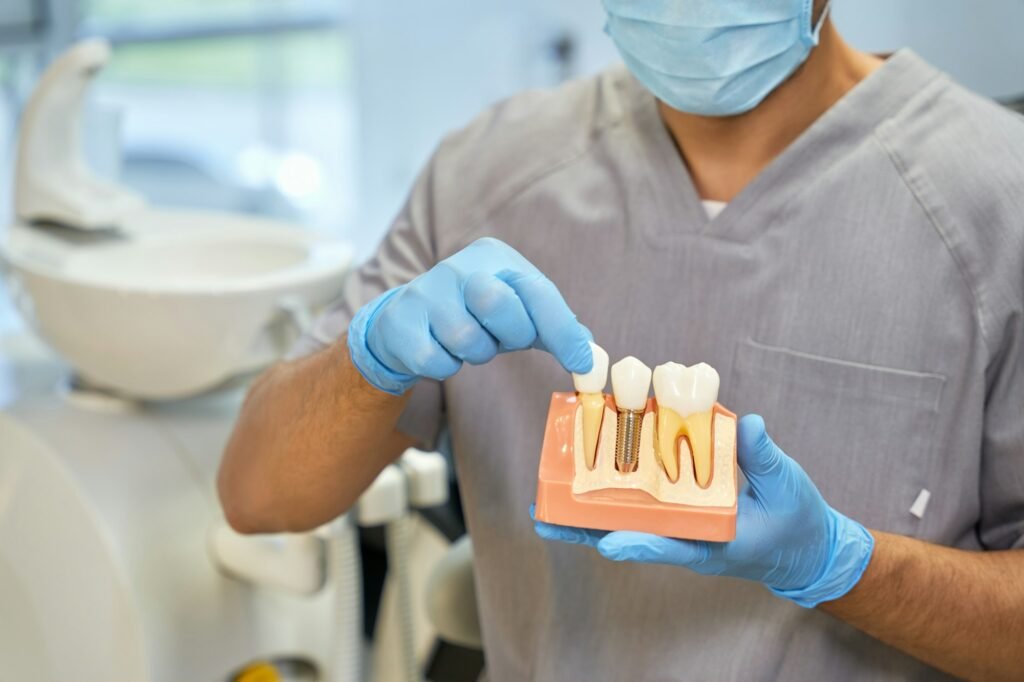Dental implants are a modern and effective solution for replacing missing teeth. They consist of artificial tooth roots made of titanium, which are surgically placed into the jawbone to support a replacement tooth or bridge. Dental implants mimic the function and appearance of natural teeth, providing a long-term solution that can improve both oral health and aesthetics.
Components of Dental Implants
- Implant Fixture:
- Material: Typically made of biocompatible titanium.
- Function: Acts as the root of the tooth, integrating with the jawbone through a process called osseointegration.
- Abutment:
- Material: Often made of titanium, gold, or porcelain.
- Function: Connects the implant fixture to the replacement tooth.
- Crown:
- Material: Porcelain, ceramic, or composite material.
- Function: Serves as the visible part of the tooth, designed to blend with natural teeth.
Indications for Dental Implants
- Replacement of a Single Tooth: Ideal for patients missing one tooth.
- Replacement of Multiple Teeth: Implants can support bridges for multiple missing teeth.
- Full Mouth Reconstruction: Implant-supported dentures or full-arch restorations for those who have lost most or all of their teeth.
- Support for Dentures: Provide stability for removable dentures.
Benefits of Dental Implants
- Natural Appearance and Function: Mimic the look and function of natural teeth.
- Durability: With proper care, dental implants can last a lifetime.
- Bone Preservation: Prevent bone loss and preserve jawbone structure.
- Improved Oral Health: Do not require the alteration of adjacent teeth, unlike traditional bridges.
- Comfort and Convenience: Eliminate the discomfort and inconvenience of removable dentures.
Procedure for Getting Dental Implants
- Initial Consultation and Examination:
- Comprehensive dental examination, including X-rays and 3D imaging.
- Assessment of bone density and structure.
- Discussion of treatment options and planning.
- Bone Grafting (if needed):
- Performed if the patient lacks sufficient bone density.
- Graft material may be taken from the patient or from a donor source.
- Implant Placement:
- Local anesthesia or sedation is administered.
- An incision is made in the gum to expose the bone.
- A hole is drilled into the bone, and the implant fixture is placed.
- The gum is stitched closed over the implant.
- Osseointegration:
- The healing process where the implant integrates with the bone.
- Takes several weeks to months.
- Abutment Placement:
- After osseointegration, a second minor surgery is performed to attach the abutment.
- The gum tissue is allowed to heal around the abutment.
- Crown Placement:
- Impressions are taken to create a custom crown.
- The crown is securely attached to the abutment.
Aftercare for Dental Implants
- Oral Hygiene: Maintain good oral hygiene practices, including brushing twice daily and flossing.
- Regular Dental Visits: Schedule regular checkups and professional cleanings.
- Diet Considerations: Avoid hard and sticky foods that could damage the implant.
- Smoking Cessation: Smoking can negatively affect the healing process and implant success.
Potential Complications
- Infection: Can occur during or after the surgery.
- Implant Failure: Rare, but can occur if the implant does not integrate with the bone.
- Nerve Damage: Possible if the implant is placed too close to a nerve.
- Sinus Issues: Implants in the upper jaw can protrude into the sinus cavities.
Success Rates and Longevity
- High Success Rates: Generally, dental implants have a success rate of up to 98%.
- Long-Lasting: With proper care, dental implants can last a lifetime, making them a cost-effective solution over time.
Conclusion
Dental implants offer a robust and aesthetically pleasing solution for tooth loss, significantly improving the patient’s quality of life. The process involves several stages, from initial consultation to final crown placement, ensuring a customized and effective treatment plan. Proper care and regular dental visits are crucial for maintaining the longevity and success of dental implants, making them a reliable choice for long-term oral health restoration.


